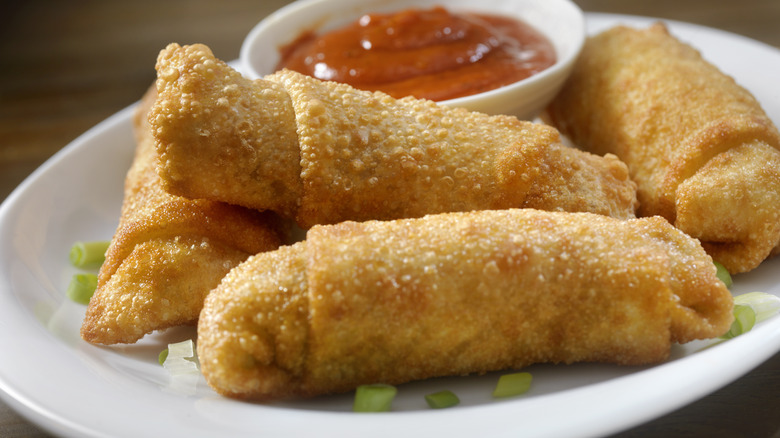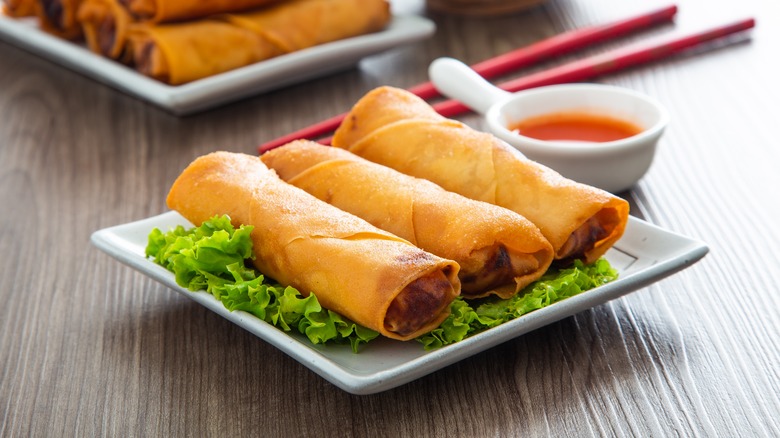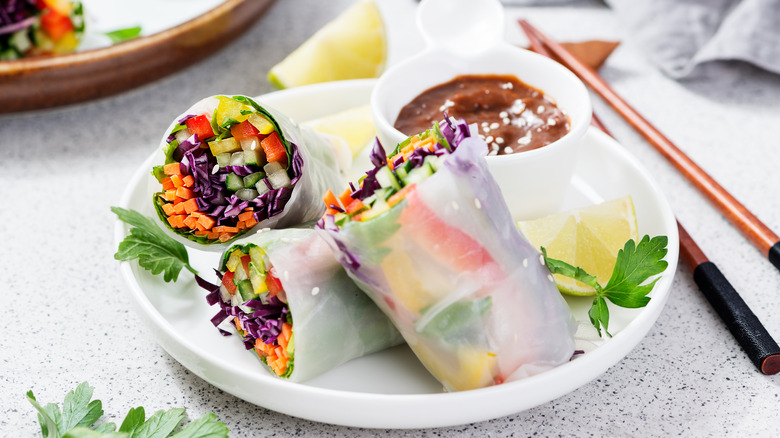Here's What Egg Roll Wrappers Are Actually Made Of
There's nothing quite like a freshly fried egg roll and its golden-brown wrapper covered in crunchy bubbles. The unique texture is absolutely craveable, as it simultaneously delivers a crunchy mouthfeel as well as a chewiness that can't be beat. This begs the question: What are egg roll wrappers made out of? One of the main ingredients in traditional egg roll wrappers is actually wheat. If you want to make your own egg roll wrappers, all you need is a few ingredients, including water, salt, and flour, a pantry staple that is super easy to work with.
Given their name, it seems like eggs would be an ingredient in the wrapper, since they're not included in the filling. Yes, eggs are a main ingredient in many egg roll wrappers (but not all of them), and they're an important part of how many wrappers get that very specific crispy-yet-chewy texture. As it turns out, however, that's probably not where the name comes from.
How did egg rolls get their name?
Most foods aren't named after a specific ingredient unless its flavor is pretty pronounced. Put simply, egg rolls don't really taste like eggs, nor can you see the eggs in the final product. So it does seem pretty strange that they would be named after one of the many ingredients that are used to make the wrappers. A more likely possibility is that the name was borrowed from another dish: "dan gun."
Instead of the crispy-yet-chewy wrapper that egg rolls are known for, dan gun's outer layer was made with eggs. But like modern-day egg rolls, the inside was stuffed with veggies and meat. The dish dates from a 1917 cookbook on Chinese-American cuisine and was featured again in a forthcoming periodical and pamphlet during the first half of the 20th century. While this sliced roll wrapped in egg very well could have been the inspiration for the term egg roll, there's really no way to know for certain. The origin of the classic egg roll is up for debate, after all, as it bears a strong resemblance to the Chinese spring roll (which does not use egg in its wrapper). Perhaps its name was borrowed from the omelet-wrapped Chinese-American roll, while its modified deep-fried pastry wrapping evolved from the actual spring roll.
Alternative egg roll wrappers
The combination of wheat and eggs might seem to exclude vegans or people with either celiac disease or gluten intolerance from enjoying egg roll wrappers. But fear not — there are alternatives. For example, plant-based brands of egg roll wrappers actually do not contain eggs and are labeled as vegan. And since spring roll wrappers do not contain eggs (though they do contain flour), these wrappers are also vegan-friendly as well.
Gluten-free alternatives are also available, including rice paper made for frying spring rolls, pre-made, gluten-free egg rolls, and mixes to make your own gluten-free egg roll wrappers. Or, you can make your own wrappers using a gluten-free flour blend. You can also make salad rolls or summer rolls, which are spring rolls that are made with a rice wrapper and served without frying. These are suitable for gluten-free diets and, while they often include shrimp, many restaurants also serve a vegan version.


